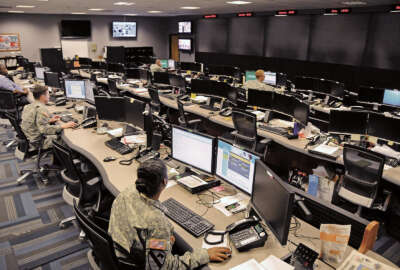OPM proposes new pay rules for feds working above their pay grade
In today's Federal Newscast: Foggy Bottom has signed an agreement with the Smithsonian to assist in international expansion. New requirements in the law require...
- Like a lot of other people, feds sometimes get temporarily assigned to do work that is technically above their pay grade. The Office of Personnel Management (OPM) is proposing new rules to make sure they get paid accordingly. As of now, agencies can tell employees to work on things that are supposed to be done by more senior workers. While that is happening, they can also earn higher pay, but only for four months. The new rule would remove that 120-day cap. The proposed regulation is in today’s Federal Register. OPM will take public comments through the end of February.(OPM issues proposed rule for time limited promotions - federalregister.gov)
- Nearly two years in the making, GSA is giving industry a second look at its new governmentwide cloud contract. The General Services Administration (GSA) is finally out with its revised and much-anticipated ASCEND cloud services blanket purchase agreement This second draft Performance Work Statement (PWS) details almost two-years of analysis for how best to create a new governmentwide contract for cloud services. GSA is seeking feedback on its Pool 1 PWS for infrastructure-and platform-as-a-service cloud services. It also offered general ideas for Pools 2 and 3, software-as-a-service and IT professional services. Comments on the draft performance statement of work are due by Jan. 30.(GSA issues draft PWS for ASCEND cloud BPA - SAM.gov)
- Agencies need to do a better job of working together to address cyber threats to medical devices, according to a new report from the Government Accountability Office. GAO said cybersecurity vulnerabilities in medical devices can pose a risk to hospital networks and patients. But the auditors found the Food and Drug Administration (FDA), and the Cybersecurity and Infrastructure Security Agency (CISA), have not refreshed their cybersecurity coordination plans in more than five years. CISA and the FDA agreed with GAO’s recommendations to update their information sharing agreements. (GAO report on medical device cybersecurity - Government Accountability Office)
- The Cybersecurity and Infrastructure Security Agency (CISA) wants to take advantage of advances in machine learning. The Department of Homeland Security’s Science and Technology Directorate is working on a new machine-learning platform for CISA. It is called the CISA Advanced Analytics Platform For Machine Learning (CAPM)for short. The platform is envisioned as a multi-cloud, multi-tenant environment for testing new software and tools, and developing complex machine-learning capabilities. The DHS S&T Directorate put out a request for information on the project earlier this month, with responses due by Jan. 15.
- The Smithsonian will expand internationally, thanks to a multi-part agreement with Foggy Bottom. Smithsonian scientists will join the State Department's Embassy Science Fellows program. Other Smithsonian staff members will help preserve traditional crafts in Mexico. Still others will become part of an international exchange program for sharing best practices for inclusive museums. Secretary of State Antony Blinken says the agreement will support three foreign policy priorities: education, the environment and cultural preservation. The Secretary of State and the Secretary of the Smithsonian Lonnie Bunch, signed the memorandum of understanding shortly before Christmas.
- The annual defense policy bill that was signed into law last week will require the Pentagon to set departmentwide standards for livable military housing. The Defense Department will have to establish standards for floor space and the number of service members allowed to live in barracks. It will also have to develop health-and-safety standards, as well as fire-and-electrical-safety standards, in an effort to improve the conditions service members are living in. Lawmakers have been calling on Pentagon officials to fix military housing, as evidence of dire barracks conditions mounted over the past year. Earlier this year, a Government Accountability Office report documented poor conditions service members have been living under for decades, including mold, no heat in the winter or air conditioning in summer. (NDAA directs Pentagon to set standards for livable barracks - Congress.gov)
- The Office of Personnel Management (OPM) is out with the first iteration of the Periodically Listing Updates to Management(PLUM) website, but it is far from complete. OPM, which is fulfilling some of the requirements of the PLUM Act of 2022, will update the portal in 90 days to confirm the completeness, accuracy and reliability of the information. Once fully updated and content-verified, OPM said the website will improve government transparency by giving the public a more up-to-date look at leadership in federal agencies, including the administration’s top leaders, political appointees and other senior positions in the federal civil service. (OPM releases initial PLUM website - Office of Personnel Management )
- The federal government is looking to industry to address workforce challenges within the Submarine Industrial Base. The General Services Administration is looking for an industry partner to develop solutions to the submarine industrial workforce problem at the local, regional and national levels. The submarine industrial base has been struggling to recruit a skilled workforce to meet its production goals. The Navy said it needs 100,000 new trade workers in the submarine industrial base over the next decade to keep up with production. The agency posted the request for proposal on Dec. 12, and companies should submit their proposals by Jan. 16.
- The Army is seeking to consolidate its legacy systems and programs into a single-user interface to provide a common operating picture. The Program Executive Office Command, Control and Communications-Tactical (PEOC3T), is looking to industry to develop solutions for the next generation of command post capabilities. The office is looking for technology to extend the basic capabilities of the government software designed to provide warfighters with real-time data and situational awareness. The service is possibly interested in executing a competitive development iteration with industry in fiscal 2024 and the prototypes may be moved to production. Companies interested in participating have until Feb. 2 to inquire.(Army is looking to modernize its command posts - SAM.gov)
Copyright © 2025 Federal News Network. All rights reserved. This website is not intended for users located within the European Economic Area.
Peter Musurlian
Peter Musurlian is a producer at Federal News Network.
Follow @PMusurlianWFED






